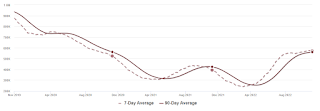Active inventory decreased slightly. Here are the same week inventory changes for the last four years (usually inventory declines seasonally through the Winter):
2022: -3.5K (smaller than usual decrease in inventory)
2021: -6.9K
2020: -5.1K
2019: -6.3K
Altos reports inventory is down 0.6% week-over-week.
 Click on graph for larger image.
Click on graph for larger image.
This inventory graph is courtesy of Altos Research.
 Click on graph for larger image.
Click on graph for larger image.This inventory graph is courtesy of Altos Research.
As of November 11th, inventory was at 572 thousand (7-day average), compared to 575 thousand the prior week.
Compared to the same week in 2021, inventory is up 45.1% from 394 thousand, and compared to the same week in 2020 inventory is up 8.9% from 525 thousand. Compared to 3 years ago (2019), inventory is down 35.9% from 892 thousand.
Here are the inventory milestones I’ve been watching for with the Altos data:
1. The seasonal bottom (happened on March 4, 2022, for Altos) ✅
2. Inventory up year-over-year (happened on May 20, 2022, for Altos) ✅
3. Inventory up compared to 2020 (happened on October 7, 2022, for Altos) ✅
4. Inventory up compared to 2019 (currently down 35.9%).
1. The seasonal bottom (happened on March 4, 2022, for Altos) ✅
2. Inventory up year-over-year (happened on May 20, 2022, for Altos) ✅
3. Inventory up compared to 2020 (happened on October 7, 2022, for Altos) ✅
4. Inventory up compared to 2019 (currently down 35.9%).
Here is a graph of the inventory change vs 2021 (milestone 2 above), 2020 (milestone 3) and 2019 (milestone 4).
The blue line is the year-over-year data, the red line is compared to two years ago, and dashed purple is compared to 2019.
A key will be if inventory declines slower than usual during the winter months.
Mike Simonsen discusses this data regularly on Youtube.

No comments:
Post a Comment
Note: Only a member of this blog may post a comment.